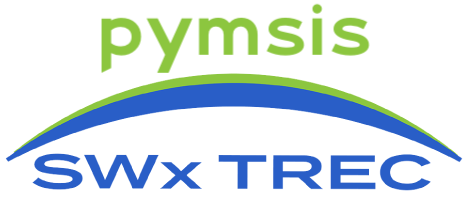Pymsis is a minimal and fast Python wrapper of the NRLMSIS models (MSISE-00, MSIS2.0, MSIS2.1). The MSIS model is developed by the Naval Research Laboratory. For quick access to the model data without any code, there is a web viewer that uses pymsis: https://swx-trec.com/msis
- Documentation
- API Reference: Details about the various options and configurations available in the functions.
- Examples: Demo for how to access and plot the data.
- Web viewer: An interactive website using pymsis through cloud-based serverless functions.
A few short lines of code to get started quickly with pymsis.
- Create a range of dates during the 2003 Halloween storm.
- Run the model at the desired location (lon, lat) (0, 0) and 400 km altitude.
- Plot the results to see how the mass density increased at 400 km altitude during this storm.
import numpy as np
import pymsis
dates = np.arange(np.datetime64("2003-10-28T00:00"), np.datetime64("2003-11-04T00:00"), np.timedelta64(30, "m"))
# geomagnetic_activity=-1 is a storm-time run
data = pymsis.calculate(dates, 0, 0, 400, geomagnetic_activity=-1)
# Plot the data
import matplotlib.pyplot as plt
# Total mass density over time
plt.plot(dates, data[:, 0, 0, 0, 0])
plt.show()note
- The model will automatically download and access the F10.7 and ap data for you if you have an internet connection.
- The returned data structure has shape [ndates, nlons, nlats, nalts, 11], but for this example we only have one point with many dates [ndates, 1, 1, 1, 11]. -s The 11 is for each of the species MSIS calculates for each input point. The first element is the Total Mass Density (kg/m3).
The MSIS model is developed by the Naval Research Laboratory.
Note that the MSIS2 code is not available for commercial use without contacting NRL. See the MSIS2 license file) for explicit details. We do not repackage the MSIS source code in this repository for that reason. However, utility functions are provided to easily download and extract the original source code. By using that code you agree to their terms and conditions.
Please acknowledge the University of Colorado Space Weather Technology, Research and Education Center (SWx TREC) and cite the original papers if you make use of this model in a publication.
Lucas, G. (2022). pymsis [Computer software]. doi:10.5281/zenodo.5348502
Emmert, J. T., Jones, M., Siskind, D. E., Drob, D. P., Picone, J. M., Stevens, M. H., et al. (2022). NRLMSIS 2.1: An empirical model of nitric oxide incorporated into MSIS. Journal of Geophysical Research: Space Physics, 127, e2022JA030896. doi:10.1029/2022JA030896
Emmert, J. T., Drob, D. P., Picone, J. M., Siskind, D. E., Jones, M., Mlynczak, M. G., et al. (2020). NRLMSIS 2.0: A whole‐atmosphere empirical model of temperature and neutral species densities. Earth and Space Science, 7, e2020EA001321. doi:10.1029/2020EA001321
Picone, J. M., Hedin, A. E., Drob, D. P., and Aikin, A. C., NRLMSISE‐00 empirical model of the atmosphere: Statistical comparisons and scientific issues, J. Geophys. Res., 107( A12), 1468, doi:10.1029/2002JA009430, 2002.
If you make use of the automatic downloads of the F10.7 and ap data, please cite that data in your publication as well. The data is downloaded from CelesTrak, which has filled in missing data from the source. Both citations are given below.
CelesTrak. https://celestrak.org/SpaceData/
Matzka, J., Stolle, C., Yamazaki, Y., Bronkalla, O. and Morschhauser, A., 2021. The geomagnetic Kp index and derived indices of geomagnetic activity. Space Weather, doi:10.1029/2020SW002641.
The easiest way to install pymsis is to install from PyPI.
pip install pymsisFor the most up-to-date pymsis, you can install directly from the git repository
pip install git+https://github.com/SWxTREC/pymsis.gitor to work on it locally, you can clone the repository and install the test dependencies.
git clone https://github.com/SWxTREC/pymsis.git
cd pymsis
pip install .[test]The installation is dependent on access to the NRL source code. If the download fails, or you have no internet access you can manually install the Fortran source code as follows. A script to help with this or give ideas on how to achieve this remote installation are provided in the tools directory).
-
Download the source code The source code is hosted on NRL's website: https://map.nrl.navy.mil/map/pub/nrl/NRLMSIS/NRLMSIS2.0/ Download the
NRLMSIS2.0.tar.gzfile to your local system. -
Extract the source files The tar file needs to be extracted to the
src/msis2.0directory.tar -xvzf NRLMSIS2.0.tar.gz -C src/msis2.0/
-
Install the Python package
pip install .

